Body Mass Index Trends for the Top Five Finishers in Men’s Grand Tour and Monument Cycling Events from 1994–2023: Implications for Athletes and Sporting Stakeholders
Abstract
1. Introduction
1.1. Weight Management Practices, Performance-Based Factors, and Elite-Level Cycling
1.2. Governance and Prestigious Competitions in Elite-Level Cycling
1.3. The Current Study
2. Methods
2.1. Design
2.2. Procedure
2.2.1. Data Collection and Validation
2.2.2. Sample Description
2.2.3. Data Analyses
2.3. Ethical Considerations
3. Results
3.1. Descriptives
3.2. Grand Tour Races
3.3. Monuments
4. Discussion
4.1. BMIs and Sporting Performance in the Grand Tours and the Monuments
4.2. BMI Trends and Health Implications
4.3. Considerations for Sporting Stakeholders in Elite-Level Cycling
5. Limitations and Directions for Future Research
6. Conclusions
Author Contributions
Funding
Institutional Review Board Statement
Data Availability Statement
Acknowledgments
Conflicts of Interest
References
- Byrne, S.; McLean, N. Elite athletes: Effects of the pressure to be thin. J. Sci. Med. Sport 2002, 5, 80–94. [Google Scholar] [CrossRef]
- Karrer, Y.; Halioua, R.; Mötteli, S.; Iff, S.; Seifritz, E.; Jäger, M.; Claussen, M.C. Disordered eating and eating disorders in male elite athletes: A scoping review. BMJ Open Sport Exerc. Med. 2020, 6, e000801. [Google Scholar] [CrossRef] [PubMed]
- Jonnalagadda, S.S.; Ziegler, P.J.; Nelson, J.A. Food preferences, dieting behaviors, and body image perceptions of elite figure skaters. Int. J. Sport Nutr. Exerc. Metab. 2004, 14, 594–606. [Google Scholar] [CrossRef]
- Gibson, C.; Hindle, C.; McLay-Cooke, R.; Slater, J.; Brown, R.; Smith, B.; Baker, D.; Healey, P.; Black, K. Body Image Among Elite Rugby Union Players. J. Strength Cond. Res. 2019, 33, 2217–2222. [Google Scholar] [CrossRef]
- Hauw, D.; Bilard, J. Understanding Appearance-Enhancing Drug Use in Sport Using an Enactive Approach to Body Image. Front. Psychol. 2017, 8, 2088. [Google Scholar] [CrossRef]
- Filaire, E.; Rouveix, M.; Pannafieux, C.; Ferrand, C. Eating attitudes, perfectionism and body-esteem of elite male judoists and cyclists. J. Sports Sci. Med. 2007, 6, 50–57. [Google Scholar] [PubMed]
- Montani, J.P.; Schutz, Y.; Dulloo, A.G. Dieting and weight cycling as risk factors for cardiometabolic diseases: Who is really at risk? Obes. Rev. 2015, 16 (Suppl. S1), 7–18. [Google Scholar] [CrossRef]
- Slater, G.; Rice, A.; Jenkins, D.; Hahn, A. Body mass management of lightweight rowers: Nutritional strategies and performance implications. Br. J. Sports Med. 2014, 48, 1529–1533. [Google Scholar] [CrossRef]
- Roberts, C.J.; Hurst, H.T.; Hardwicke, J. Eating Disorders and Disordered Eating in Competitive Cycling: A Scoping Review. Behav. Sci. 2022, 12, 490. [Google Scholar] [CrossRef] [PubMed]
- Bailey, M. Eating Disorders and Professional Cycling: The Thin End of the Wedge. 2022. Available online: https://www.bikeradar.com/features/long-reads/eating-disorders-pro-cycling/ (accessed on 14 May 2024).
- Riebl, S.K.; Subudhi, A.W.; Broker, J.P.; Schenck, K.; Berning, J.R. The prevalence of subclinical eating disorders among male cyclists. J. Am. Diet. Assoc. 2007, 107, 1214–1217. [Google Scholar] [CrossRef]
- Smith, S. Fat Shaming and Problem Eating: The Dark Side of the Tour de France. 2022. Available online: https://www.telegraph.co.uk/cycling/2022/06/29/fat-shaming-problem-eating-dark-side-tour-de-france (accessed on 14 May 2024).
- Coyle, E.F. Improved muscular efficiency displayed as Tour de France champion matures. J. Appl. Physiol. 2005, 98, 2191–2196. [Google Scholar] [CrossRef] [PubMed]
- Laverick, J. Why Get Skinny When you Could Get Fast? Why a Rebalancing of Perspectives Is Needed in Cycling. 2021. Available online: https://www.cyclingweekly.com/news/latest-news/why-get-skinny-when-you-could-get-fast-why-a-rebalancing-of-perspectives-is-needed-in-cycling-498090 (accessed on 14 May 2024).
- Ferrand, C.; Brunet, E. Perfectionism and risk for disordered eating among young French male cyclists of high performance. Percept. Mot. Skills 2004, 99, 959–967. [Google Scholar] [CrossRef] [PubMed]
- Jones, W. Cycling and Eating Disorders: My Relationship with Body Weight and the Bicycle. 2022. Available online: https://www.cyclingnews.com/features/cycling-and-eating-disorders-my-relationship-with-body-weight-and-the-bicycle (accessed on 14 May 2024).
- Ballinger, A. Sports Dietician Says Eating Disorders in Cycling are Becoming a Serious Problem. 2020. Available online: https://www.cyclingweekly.com/news/latest-news/sports-dietician-says-eating-disorders-cycling-becoming-serious-problem-445709 (accessed on 14 May 2024).
- Stout, J. Eating Habits Of (Pro) Cyclists: The Weight Debate. The Ride Review. 2015. [Google Scholar]
- The Union Cycliste Internationale. The UCI. Available online: https://www.uci.org/the-uci (accessed on 14 May 2024).
- Union Cycliste Internationale. Teams. Available online: https://www.uci.org/riders/road-riders-teams/4uEfOErsvL4hkRJriqkdiw (accessed on 20 May 2024).
- Torgler, B. “La Grande Boucle”: Determinants of Success at the Tour de France. J. Sports Econ. 2007, 8, 317–331. [Google Scholar] [CrossRef]
- Prinz, J.; Wicker, P. Team and individual performance in the Tour de France. Team Perform. Manag. 2007, 18, 418–432. [Google Scholar] [CrossRef]
- Coupé, T.; Gergaud, O. Suspicious Blood and Performance in Professional Cycling. J. Sports Econ. 2013, 14, 546–559. [Google Scholar] [CrossRef]
- Majendie, M. The Big Interview: Bradley Wiggins. 2009. Available online: https://www.standard.co.uk/sport/the-big-interview-bradley-wiggins-6789854.html (accessed on 20 May 2024).
- Van Erp, T.; Sanders, D. Demands of professional cycling races: Influence of race category and result. Eur. J. Sport Sci. 2021, 21, 666–677. [Google Scholar] [CrossRef] [PubMed]
- Gutin, I. In BMI We Trust: Reframing the Body Mass Index as a Measure of Health. Soc. Theory Health 2018, 16, 256–271. [Google Scholar] [CrossRef] [PubMed]
- World Health Organization. European Health Information Gateway: Cut-off for BMI According to WHO Standards. Available online: https://gateway.euro.who.int/en/indicators/mn_survey_19-cut-off-for-bmi-according-to-who-standards (accessed on 20 May 2024).
- American Psychiatric Association. Diagnostic and Statistical Manual of Mental Disorders; American Psychiatric Association: Washington, DC, USA, 2013. [Google Scholar]
- Yeager, S. Cyclists, It’s Time to Say Bye Bye to BMI. 2022. Available online: https://www.bicycling.com/training/a20042103/cyclists-its-time-to-say-bye-bye-to-bmi (accessed on 19 June 2024).
- Maciejczyk, M.; Wiecek, M.; Szymura, J.; Szygula, Z.; Brown, L.E. Influence of increased body mass and body composition on cycling anaerobic power. J. Strength Cond. Res. 2015, 29, 58–65. [Google Scholar] [CrossRef] [PubMed]
- Mujika, I.; Rønnestad, B.R.; Martin, D.T. Effects of Increased Muscle Strength and Muscle Mass on Endurance-Cycling Performance. Int. J. Sports Physiol. Perform. 2016, 11, 283–289. [Google Scholar] [CrossRef]
- de Wit, L.M.; van Straten, A.; van Herten, M.; Penninx, B.W.; Cuijpers, P. Depression and body mass index, a u-shaped association. BMC Public Health 2009, 9, 14. [Google Scholar] [CrossRef]
- Aune, D.; Sen, A.; Prasad, M.; Norat, T.; Janszky, I.; Tonstad, S.; Romundstad, P.; Vatten, L.J. BMI and all cause mortality: Systematic review and non-linear dose-response meta-analysis of 230 cohort studies with 3.74 million deaths among 30.3 million participants. BMJ 2016, 353, i2156. [Google Scholar] [CrossRef]
- Ha, J.; Baek, K.H. Body mass index at the crossroads of osteoporosis and type 2 diabetes. Korean J. Intern. Med. 2020, 35, 1333–1335. [Google Scholar] [CrossRef]
- ProCyclingStats. Statistics. Available online: https://www.procyclingstats.com/statistics.php (accessed on 20 March 2024).
- Cohen, J. Statistical Power Analysis for the Behavioral Sciences; Lawrence Erlbaum Associates: Hillsdale, MI, USA, 1988. [Google Scholar]
- Swain, D.P. The influence of body mass in endurance bicycling. Med. Sci. Sports Exerc. 1994, 26, 58–63. [Google Scholar] [CrossRef]
- Lippi, G.; Mattiuzzi, C. Relationship between Anthropometric Characteristics and Success in Different Cycling Terrains. J. Lifestyle Med. 2020, 10, 61–63. [Google Scholar] [CrossRef]
- Le Tour. Overall Route. Available online: https://www.letour.fr/en/overall-route (accessed on 16 May 2024).
- van Erp, T.; Kittel, M.; Lamberts, R.P. Demands of the Tour de France: A Case Study of a World-Class Sprinter (Part I). Int. J. Sports Physiol Perform. 2021, 16, 1363–1370. [Google Scholar] [CrossRef] [PubMed]
- Lee, D.H.; Keum, N.; Rezende, L.F.M.; Tabung, F.K.; Hong, S.; Giovannucci, E.L. Association between weight cycling and risk of kidney cancer: A prospective cohort study and meta-analysis of observational studies. Cancer Causes Control. 2021, 32, 1029–1038. [Google Scholar] [CrossRef] [PubMed]
- Forney, K.J.; Buchman-Schmitt, J.M.; Keel, P.K.; Frank, G.K. The medical complications associated with purging. Int. J. Eat. Disord. 2016, 49, 249–259. [Google Scholar] [CrossRef]
- Roerig, J.L.; Steffen, K.J.; Mitchell, J.E.; Zunker, C. Laxative abuse: Epidemiology, diagnosis and management. Drugs 2010, 70, 1487–1503. [Google Scholar] [CrossRef] [PubMed]
- Chang, C.J.; Putukian, M.M.; Aerni, G.; Diamond, A.B.D.; Hong, E.S.; Ingram, Y.M.; Reardon, C.L.; Wolanin, A.T.P. Mental Health Issues and Psychological Factors in Athletes: Detection, Management, Effect on Performance, and Prevention: American Medical Society for Sports Medicine Position Statement. Clin. J. Sport Med. 2020, 30, e61–e87. [Google Scholar] [CrossRef]
- Logue, D.M.; Madigan, S.M.; Melin, A.; Delahunt, E.; Heinen, M.; Mc Donnell, S.-J.; Corish, C.A. Low Energy Availability in Athletes 2020: An Updated Narrative Review of Prevalence, Risk, Within-Day Energy Balance, Knowledge, and Impact on Sports Performance. Nutrients 2020, 12, 835. [Google Scholar] [CrossRef]
- Mountjoy, M.; E Ackerman, K.; Bailey, D.M.; Burke, L.M.; Constantini, N.; Hackney, A.C.; Heikura, I.A.; Melin, A.; Pensgaard, A.M.; Stellingwerff, T.; et al. International Olympic Committee’s (IOC) consensus statement on Relative Energy Deficiency in Sport (REDs). Br. J. Sports Med. 2023, 57, 1073–1097. [Google Scholar] [CrossRef] [PubMed]
- Keay, N.; Francis, G.; Hind, K. Low energy availability assessed by a sport-specific questionnaire and clinical interview indicative of bone health, endocrine profile and cycling performance in competitive male cyclists. BMJ Open Sport Exerc. Med. 2018, 4, e000424. [Google Scholar] [CrossRef] [PubMed]
- Hilkens, L.; van Schijndel, N.; Weijer, V.; Boerboom, M.; van der Burg, E.; Peters, V.; Kempers, R.; Bons, J.; van Loon, L.J.C.; van Dijk, J.W. Low Bone Mineral Density and Associated Risk Factors in Elite Cyclists at Different Stages of a Professional Cycling Career. Med. Sci. Sports Exerc. 2023, 55, 957–965. [Google Scholar] [CrossRef] [PubMed]
- Nichols, J.F.; Rauh, M.J. Longitudinal changes in bone mineral density in male master cyclists and nonathletes. J. Strength Cond. Res. 2011, 25, 727–734. [Google Scholar] [CrossRef] [PubMed]
- Hoon, M.W.; Haakonssen, E.C.; Menaspà, P.; Burke, L.M. Racing weight and resistance training: Perceptions and practices in trained male cyclists. Phys. Sportsmed. 2019, 47, 421–426. [Google Scholar] [CrossRef] [PubMed]
- Global Cycling Network. How to Climb like Movistar’s Mikel Landa. 2019. Available online: https://www.youtube.com/watch?v=oIdlHlbSzqY (accessed on 1 May 2024).
- Webber, E. Ex-World Champion Cyclist Janez Brajkovic Shares Shocking Pictures of His Emaciated Legs after His Comeback Race Following a Ten-Month Doping Ban and Debilitating Battle with Bulimia. Daily Mail. Available online: https://www.dailymail.co.uk/news/article-7565535/Cyclist-shares-pictures-emaciated-legs-following-ten-month-doping-ban-battle-bulimia.html (accessed on 1 May 2024).
- Union Cycliste Internationale. Agenda 2030. 2022. Available online: https://www.uci.org/2030-cyclings-agenda/6IvT7HIQybfVcb2kZczQAQ (accessed on 1 May 2024).
- Müller, W.; Gröschl, W.; Müller, R.; Sudi, K. Underweight in ski jumping: The solution of the problem. Int. J. Sports Med. 2006, 27, 926–934. [Google Scholar] [CrossRef] [PubMed]
- Fédération Internationale de l’Automobile. 2023 Formula 1 Technical Regulations. Available online: https://www.fia.com/sites/default/files/fia_2023_formula_1_technical_regulations_-_issue_2_-_2022-08-16.pdf (accessed on 16 May 2024).
- Union Cycliste Internationale. The Support of Riders’ Mental Health. Available online: https://www.uci.org/mental-health/3U57vF98R1zjolF0WNDWIT (accessed on 1 May 2024).
- Smith, A.; Buadze, A.; Colangelo, J.; Liebrenz, M. A Review of Mental Health Issues in High-Performance and Elite-Level Cycling. Int. J. Sports Med. 2023, 44, 1034–1042. [Google Scholar] [CrossRef] [PubMed]
- Cook, O.; Dobbin, N. The association between sport nutrition knowledge, nutritional intake, energy availability, and training characteristics with the risk of an eating disorder amongst highly trained competitive road cyclists. Sport Sci. Health 2022, 18, 1243–1251. [Google Scholar] [CrossRef]
- Nowicka, P.; Eli, K.; Ng, J.; Apitzsch, E.; Sundgot-Borgen, J. Moving from Knowledge to Action: A Qualitative Study of Elite Coaches’ Capacity for Early Intervention in Cases of Eating Disorders. Int. J. Sports Sci. Coach. 2013, 8, 343–355. [Google Scholar] [CrossRef]
- Ackland, T.; Lohman, T.G.; Sundgot-Borgen, J.; Maughan, R.J.; Meyer, N.L.; Stewart, A.; Müller, W.; Ackland, W.P.T.R. Current status of body composition assessment in sport: Review and position statement on behalf of the ad hoc research working group on body composition health and performance, under the auspices of the I.O.C. Medical Commission. Sports Med. 2012, 42, 227–249. [Google Scholar] [CrossRef]
- Colangelo, J.; Smith, A.; Buadze, A.; Liebrenz, M. “There just isn’t any other option-so we just have to put up with it”: Mental health in women’s cycling and the necessity of structural change. Front. Sports Act. Living 2023, 5, 1270957. [Google Scholar] [CrossRef] [PubMed]
- Miller, J.; Susa, K. Comparison of anthropometric characteristics between world tour and professional continental cyclists. J. Sci. Cycl. 2018, 7, 3–6. [Google Scholar] [CrossRef]
- Kholkine, L.; Servotte, T.; de Leeuw, A.-W.; De Schepper, T.; Hellinckx, P.; Verdonck, T.; Latré, S. A Learn-to-Rank Approach for Predicting Road Cycling Race Outcomes. Front. Sports Act. Living 2021, 3, 714107. [Google Scholar] [CrossRef]
- Slater, G.J.; Duthie, G.M.; Pyne, D.B.; Hopkins, W.G. Validation of a skinfold based index for tracking proportional changes in lean mass. Br. J. Sports Med. 2006, 40, 208–213. [Google Scholar] [CrossRef] [PubMed]
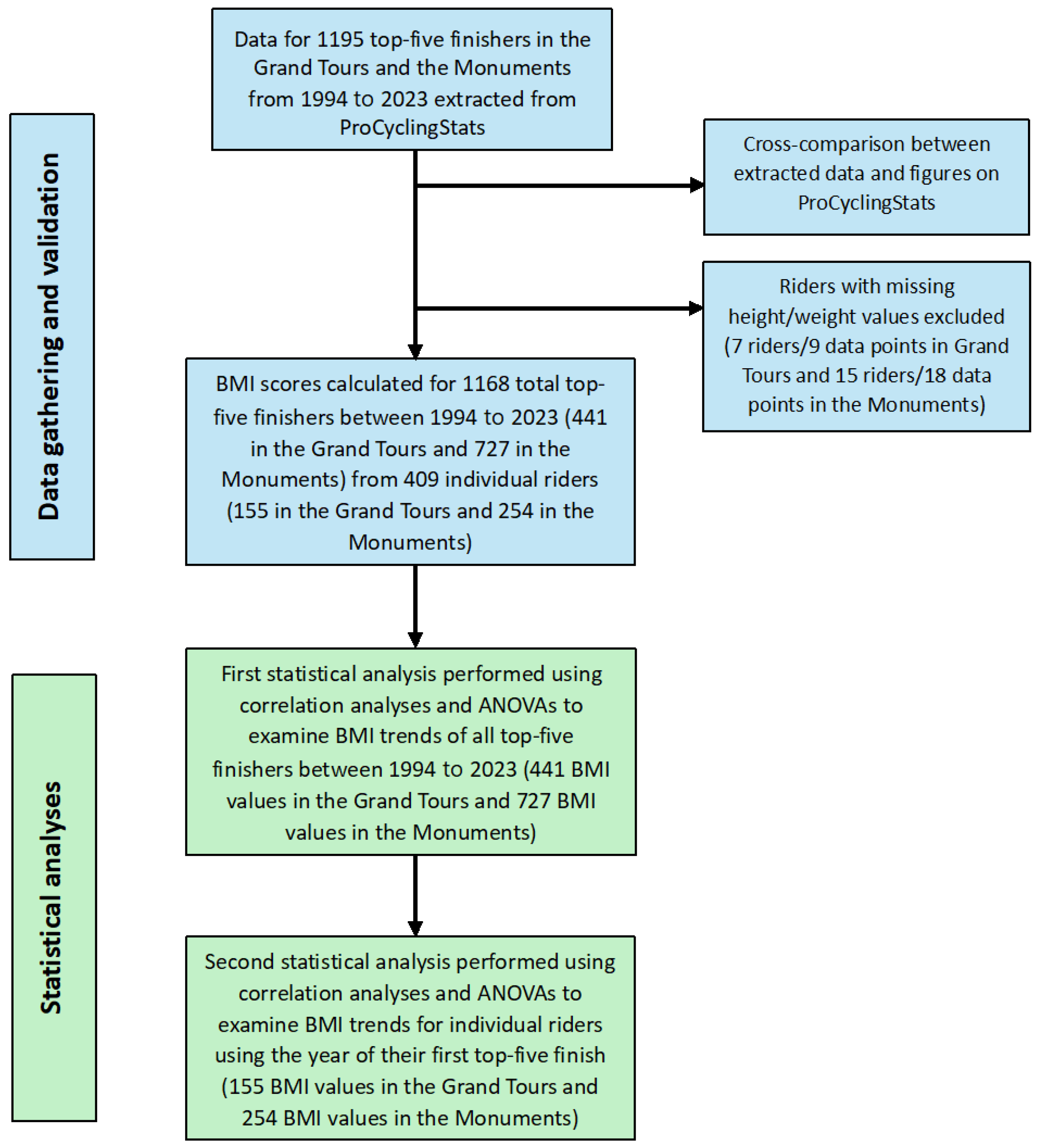
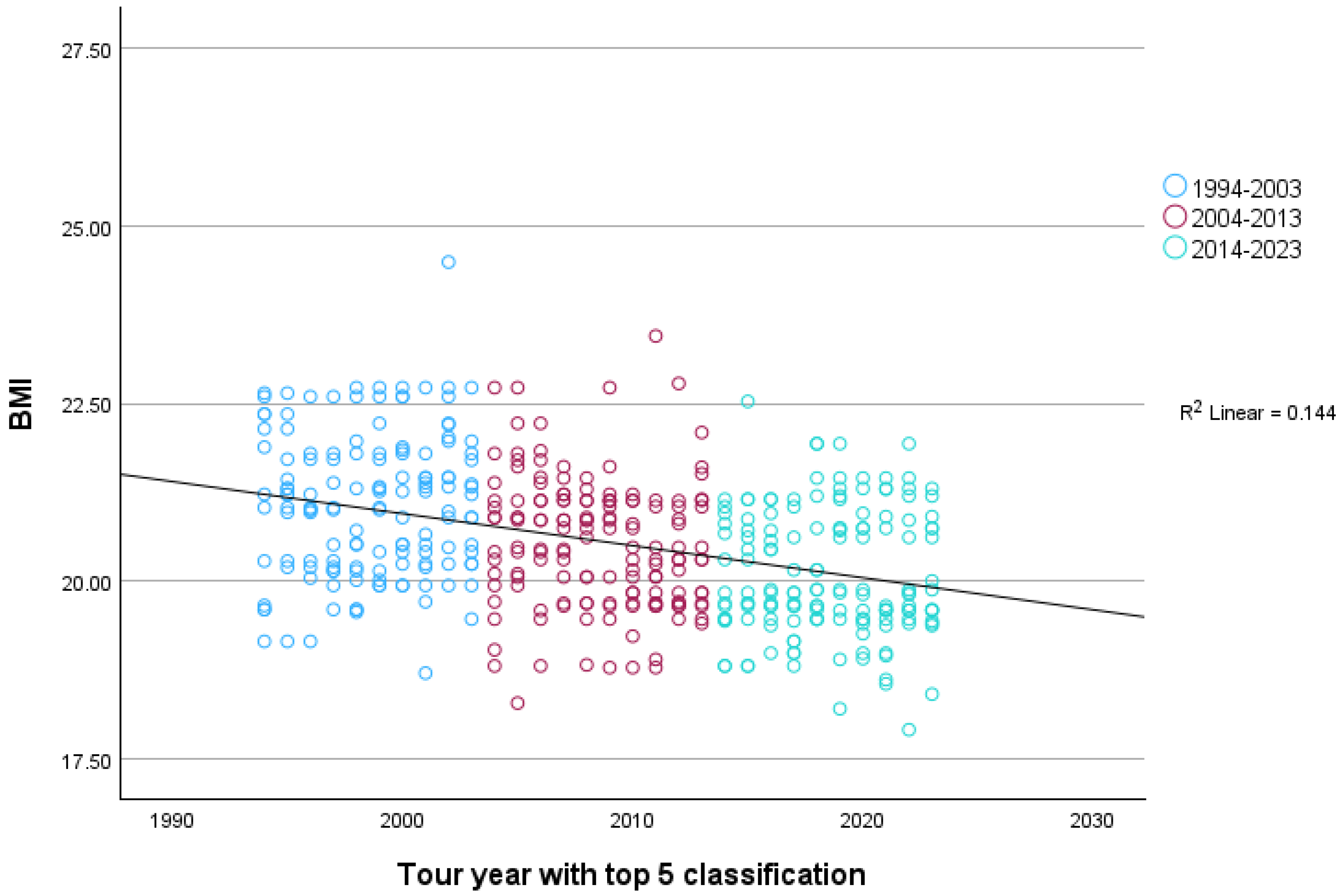
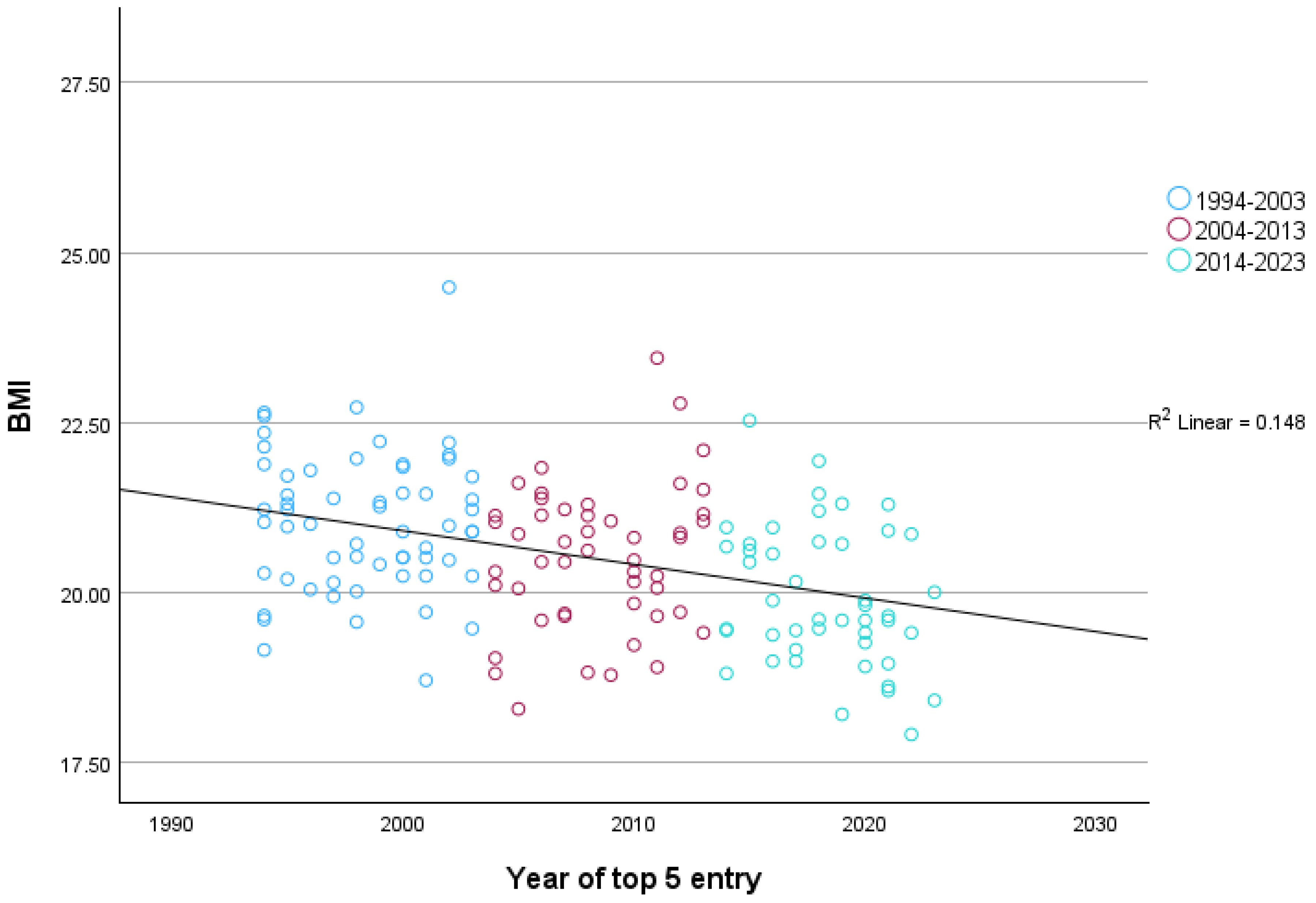
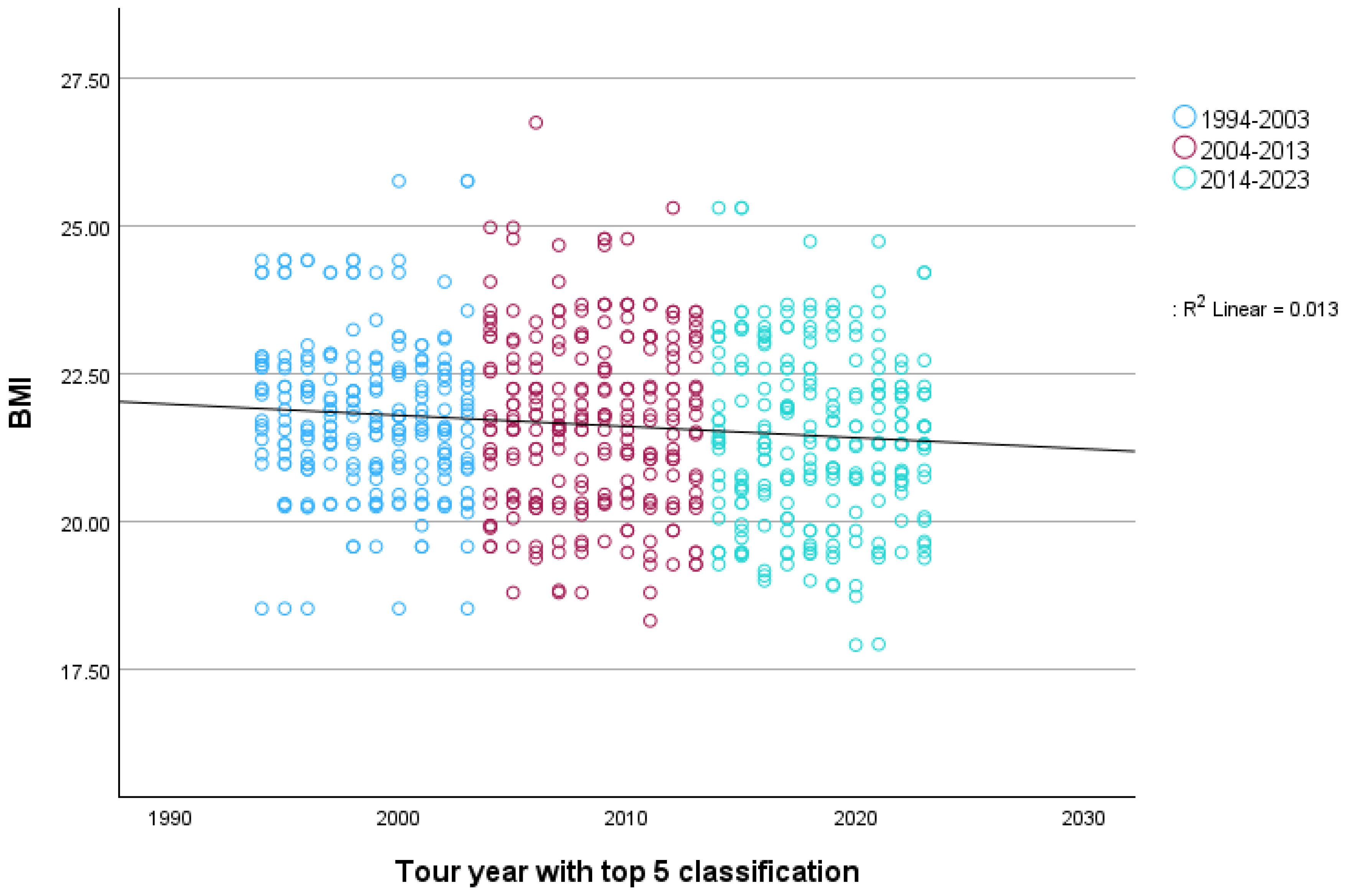
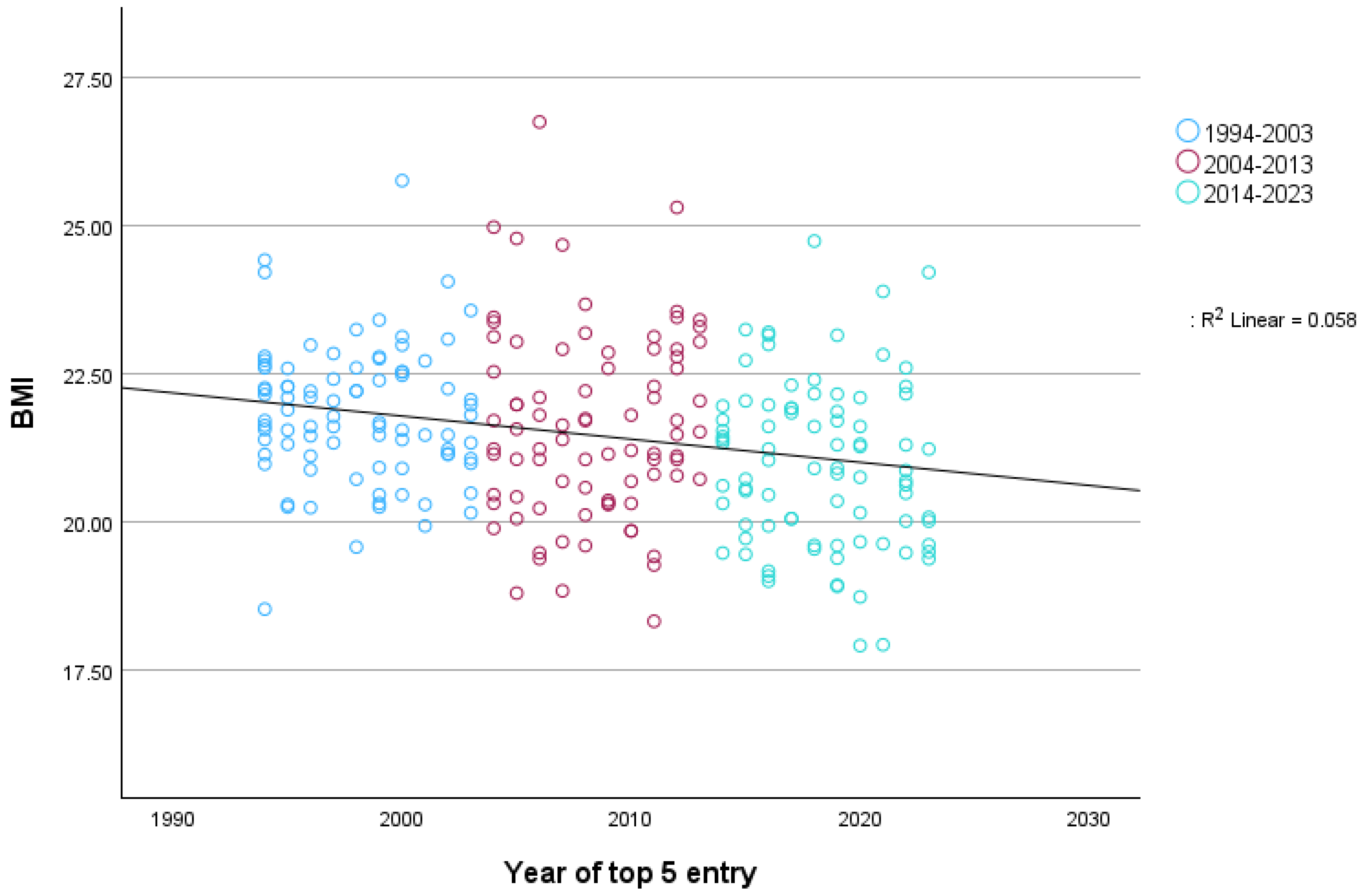
| Grand Tour | Monuments | ||||||
|---|---|---|---|---|---|---|---|
| M | SD | Min–Max | M | SD | Min–Max | Cohen’s d | |
| Weight (kg) | 64.66 | 5.00 | 48–79 | 69.04 | 6.81 | 53–94 | −0.71 *** |
| Height (cm) | 177.39 | 5.80 | 162–191 | 179.23 | 6.33 | 164–199 | −0.30 ** |
| BMI | 20.54 | 1.12 | 17.92–24.49 | 21.46 | 1.43 | 17.90–26.75 | −0.70 *** |
| Age at first top-five GC | 27.37 | 3.27 | 20–41 | 27.54 | 3.29 | 21–38 | −0.05 *** |
| Number of top-five classifications | 2.78 | 2.59 | 1–14 | 2.77 | 2.91 | 1–17 | −0.00 *** |
Disclaimer/Publisher’s Note: The statements, opinions and data contained in all publications are solely those of the individual author(s) and contributor(s) and not of MDPI and/or the editor(s). MDPI and/or the editor(s) disclaim responsibility for any injury to people or property resulting from any ideas, methods, instructions or products referred to in the content. |
© 2024 by the authors. Licensee MDPI, Basel, Switzerland. This article is an open access article distributed under the terms and conditions of the Creative Commons Attribution (CC BY) license (https://creativecommons.org/licenses/by/4.0/).
Share and Cite
Smith, A.; Wyler, H.; van Wijnkoop, M.; Colangelo, J.; Liebrenz, M.; Buadze, A. Body Mass Index Trends for the Top Five Finishers in Men’s Grand Tour and Monument Cycling Events from 1994–2023: Implications for Athletes and Sporting Stakeholders. Sports 2024, 12, 178. https://doi.org/10.3390/sports12070178
Smith A, Wyler H, van Wijnkoop M, Colangelo J, Liebrenz M, Buadze A. Body Mass Index Trends for the Top Five Finishers in Men’s Grand Tour and Monument Cycling Events from 1994–2023: Implications for Athletes and Sporting Stakeholders. Sports. 2024; 12(7):178. https://doi.org/10.3390/sports12070178
Chicago/Turabian StyleSmith, Alexander, Helen Wyler, Moritz van Wijnkoop, Jill Colangelo, Michael Liebrenz, and Anna Buadze. 2024. "Body Mass Index Trends for the Top Five Finishers in Men’s Grand Tour and Monument Cycling Events from 1994–2023: Implications for Athletes and Sporting Stakeholders" Sports 12, no. 7: 178. https://doi.org/10.3390/sports12070178
APA StyleSmith, A., Wyler, H., van Wijnkoop, M., Colangelo, J., Liebrenz, M., & Buadze, A. (2024). Body Mass Index Trends for the Top Five Finishers in Men’s Grand Tour and Monument Cycling Events from 1994–2023: Implications for Athletes and Sporting Stakeholders. Sports, 12(7), 178. https://doi.org/10.3390/sports12070178






